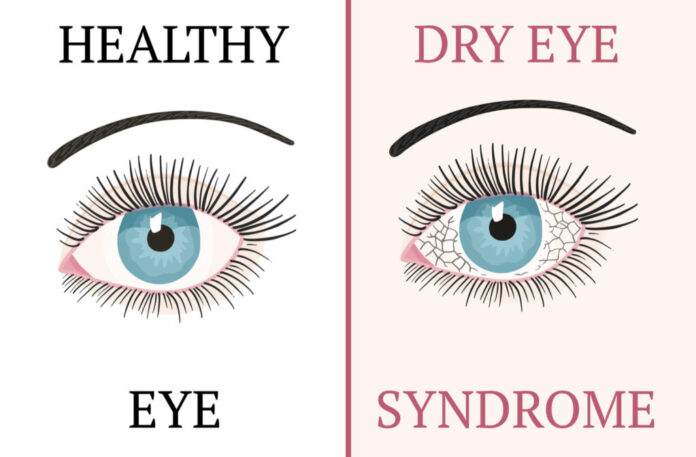Dry Eye Syndrome, also known as dry eye disease or keratoconjunctivitis sicca, is a common condition that occurs when your tears aren’t able to provide adequate lubrication for your eyes. This can happen if you don’t produce enough tears or if you produce poor-quality tears.
Symptoms
Common symptoms of dry eye syndrome include:
- A stinging, burning, or scratchy sensation in your eyes
- Stringy mucus in or around your eyes
- Increased eye irritation from smoke or wind
- Eye fatigue after reading or using a computer
- Sensitivity to light
- Redness of the eyes
- A sensation of having something in your eyes
- Difficulty wearing contact lenses
- Blurred vision or eye fatigue
Causes
Dry eye syndrome can be caused by various factors, including:
- Reduced Tear Production: Age-related changes, certain medical conditions (like diabetes, rheumatoid arthritis, or thyroid disorders), and medications (like antihistamines, decongestants, and antidepressants) can reduce tear production.
- Increased Tear Evaporation: Environmental factors (like wind, smoke, or dry air), prolonged screen time, and not blinking often enough can cause tears to evaporate more quickly.
- Tear Composition: Problems with the composition of tears, such as a deficiency in any of the three layers of the tear film (oil, water, and mucus), can cause dry eyes. This is often related to dysfunction of the meibomian glands in the eyelids.
Treatment
Treatment for dry eye syndrome aims to restore or maintain the normal amount of tears in the eyes to minimize dryness and discomfort and to maintain eye health. Common treatments include:
- Lifestyle Changes and Home Remedies:
- Using a humidifier to add moisture to the air
- Taking breaks during prolonged tasks like reading or using a computer
- Wearing sunglasses or other protective eyewear to reduce tear evaporation
- Artificial Tears and Eye Drops: Over-the-counter artificial tears can provide temporary relief.
- Prescription Medications: Anti-inflammatory drugs, such as cyclosporine (Restasis) or lifitegrast (Xiidra), can increase tear production and reduce inflammation.
- Punctal Plugs: These tiny plugs can be inserted into the tear ducts to block drainage and keep tears on the eye surface longer.
- Meibomian Gland Expression: This procedure involves applying heat and pressure to the eyelids to open blocked glands.
- Surgery: In severe cases, surgery to close the tear ducts that drain tears from your eyes (punctual occlusion) might be an option.
Prevention
Preventive measures can help reduce the risk of developing dry eye syndrome or alleviate symptoms:
- Environmental Control: Avoid smoke, wind, and dry air whenever possible. Use protective eyewear in windy or dry environments.
- Proper Blink Rate: Be conscious of blinking regularly, especially when using digital devices or reading.
- Hydration: Drink plenty of water to stay hydrated.
- Diet: Include foods rich in omega-3 fatty acids, such as fish, flaxseed, and walnuts, which can improve eye health.
- Regular Eye Exams: Have regular eye check-ups to monitor eye health and address any issues early.
If you experience persistent symptoms of dry eye, it’s essential to consult an eye care professional for a thorough evaluation and personalized treatment plan.































